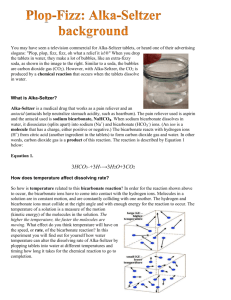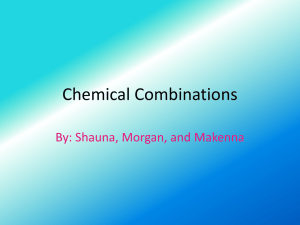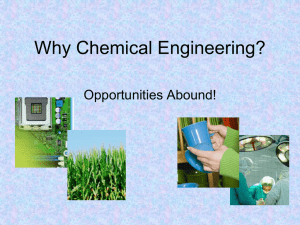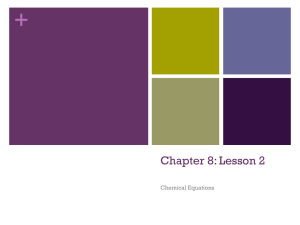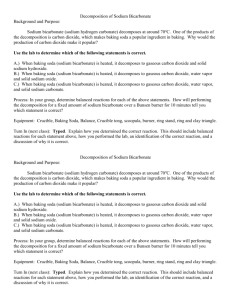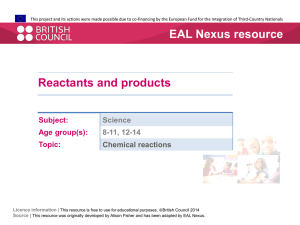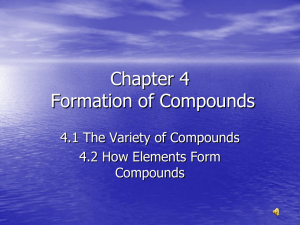Project Fact File
advertisement
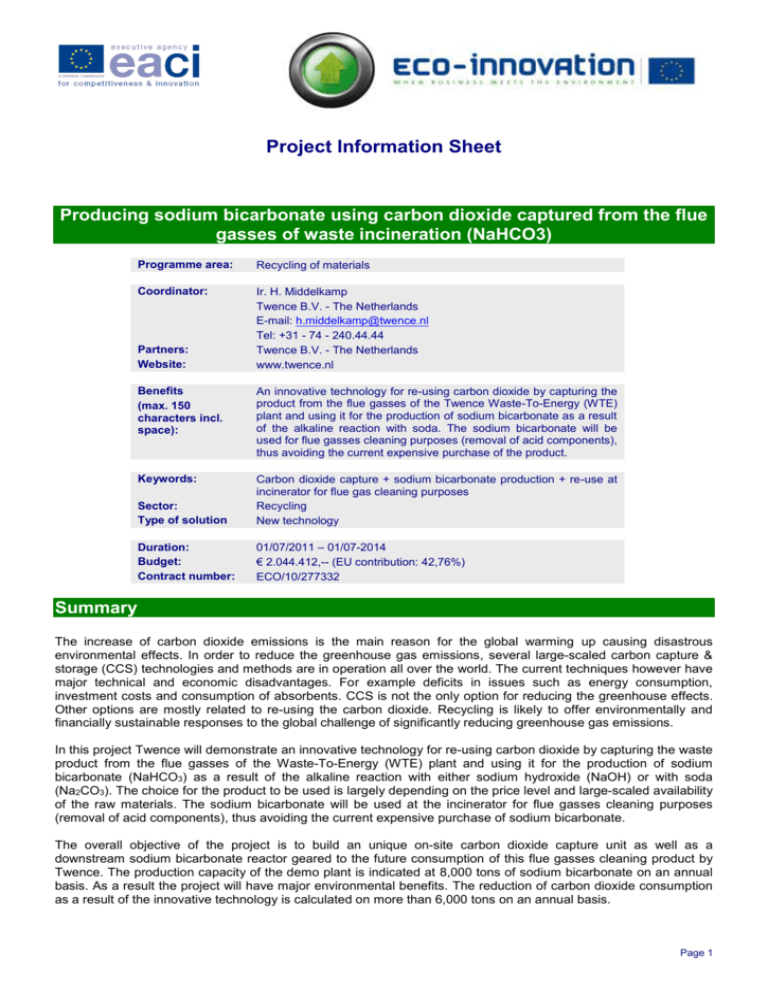
Project Information Sheet Producing sodium bicarbonate using carbon dioxide captured from the flue gasses of waste incineration (NaHCO3) Programme area: Recycling of materials Coordinator: Ir. H. Middelkamp Twence B.V. - The Netherlands E-mail: h.middelkamp@twence.nl Tel: +31 - 74 - 240.44.44 Twence B.V. - The Netherlands www.twence.nl Partners: Website: Benefits (max. 150 characters incl. space): An innovative technology for re-using carbon dioxide by capturing the product from the flue gasses of the Twence Waste-To-Energy (WTE) plant and using it for the production of sodium bicarbonate as a result of the alkaline reaction with soda. The sodium bicarbonate will be used for flue gasses cleaning purposes (removal of acid components), thus avoiding the current expensive purchase of the product. Keywords: Sector: Type of solution Carbon dioxide capture + sodium bicarbonate production + re-use at incinerator for flue gas cleaning purposes Recycling New technology Duration: Budget: Contract number: 01/07/2011 – 01/07-2014 € 2.044.412,-- (EU contribution: 42,76%) ECO/10/277332 Summary The increase of carbon dioxide emissions is the main reason for the global warming up causing disastrous environmental effects. In order to reduce the greenhouse gas emissions, several large-scaled carbon capture & storage (CCS) technologies and methods are in operation all over the world. The current techniques however have major technical and economic disadvantages. For example deficits in issues such as energy consumption, investment costs and consumption of absorbents. CCS is not the only option for reducing the greenhouse effects. Other options are mostly related to re-using the carbon dioxide. Recycling is likely to offer environmentally and financially sustainable responses to the global challenge of significantly reducing greenhouse gas emissions. In this project Twence will demonstrate an innovative technology for re-using carbon dioxide by capturing the waste product from the flue gasses of the Waste-To-Energy (WTE) plant and using it for the production of sodium bicarbonate (NaHCO3) as a result of the alkaline reaction with either sodium hydroxide (NaOH) or with soda (Na2CO3). The choice for the product to be used is largely depending on the price level and large-scaled availability of the raw materials. The sodium bicarbonate will be used at the incinerator for flue gasses cleaning purposes (removal of acid components), thus avoiding the current expensive purchase of sodium bicarbonate. The overall objective of the project is to build an unique on-site carbon dioxide capture unit as well as a downstream sodium bicarbonate reactor geared to the future consumption of this flue gasses cleaning product by Twence. The production capacity of the demo plant is indicated at 8,000 tons of sodium bicarbonate on an annual basis. As a result the project will have major environmental benefits. The reduction of carbon dioxide consumption as a result of the innovative technology is calculated on more than 6,000 tons on an annual basis. Page 1 The main partial objectives of the demo project are: Demonstration of an unique carbon dioxide capture technology leading to lower investment costs, lower consumption of absorption liquids as well as lower operational costs; Demonstration of the re-use of the captured carbon dioxide for the on-site production of sodium bicarbonate to be used in the flue gasses cleaning system of the WTE plant; Evaluation of the concept of on-site production, storage and re-use of carbon dioxide; Review of the financial-economic perspective of the new technology. The project has started on 1 July 2011. De duration of the demo is calculated on 36 months. The execution is structured according to work packages (WP). The project will start by evaluating the process plant design. Based on this result the process of acquiring the required permissions will be started as well as the detailed engineering and dimensioning of the demo plant. In the next WP the tender procedures for the selection of a general contractor as well as suppliers of raw material will be performed, followed by the construction and start-up of the demo plant. After accepting the demo plant it will be subject to a substantial experimental program. The results of this program will be monitored to measure and document the effectiveness of the actions taken. Finally, the results will be evaluated and reports will be made. In addition dissemination and networking activities will be performed. Expected and/or achieved results The demo plant will initially aim at acquiring knowledge and know-how related to the proposed innovative technology in the shape of testing, validating and - if necessary - adjusting the production process. At the same time by realizing the installation the operational objective of the project is the production of the required volume of sodium bicarbonate to be used for flue gasses cleaning purposes at the Twence site. The major results of the project are to be divided into know-how, technical and economic outcomes: Know-how: Validation of the chemical, thermodynamic and physical properties of the system; Validation of the process models, model calculations and simulations; Validation of the effects of the process conditions on the product properties. Technical deliverables: Detailed design of both the carbon capture plant as well as the sodium bicarbonate reactor; Construction of a demo plant with a capacity of 8,000 tons of sodium bicarbonate on an annual basis; Technical evaluation of both the carbon capture process as well as the re-use process; Integration of the demo plan with the regular WTE-plant (specifically with the flue gasses cleaning system). Economic deliverables: Availability, volumes and prices on the raw materials; Evaluation of the storage, transport and recycling of raw materials and finished product; Business process evaluation (operational costs, level of investment and return-on-investment); Calculation of the market volume of the demonstrated technology. The information sheet will be published in the Eco-Innovation website. The EACI reserves the right to edit the information sheet for content and length Page 2

